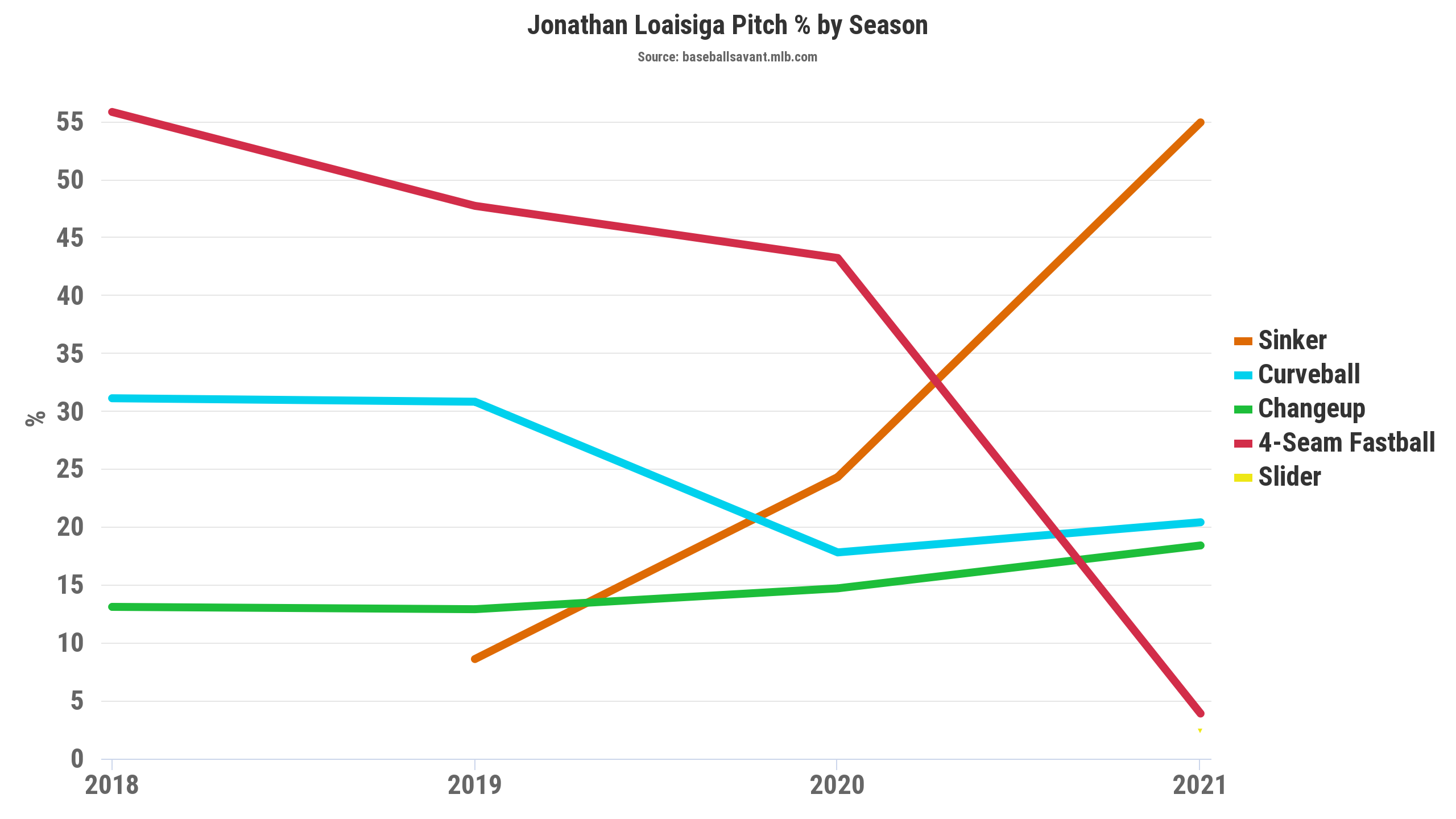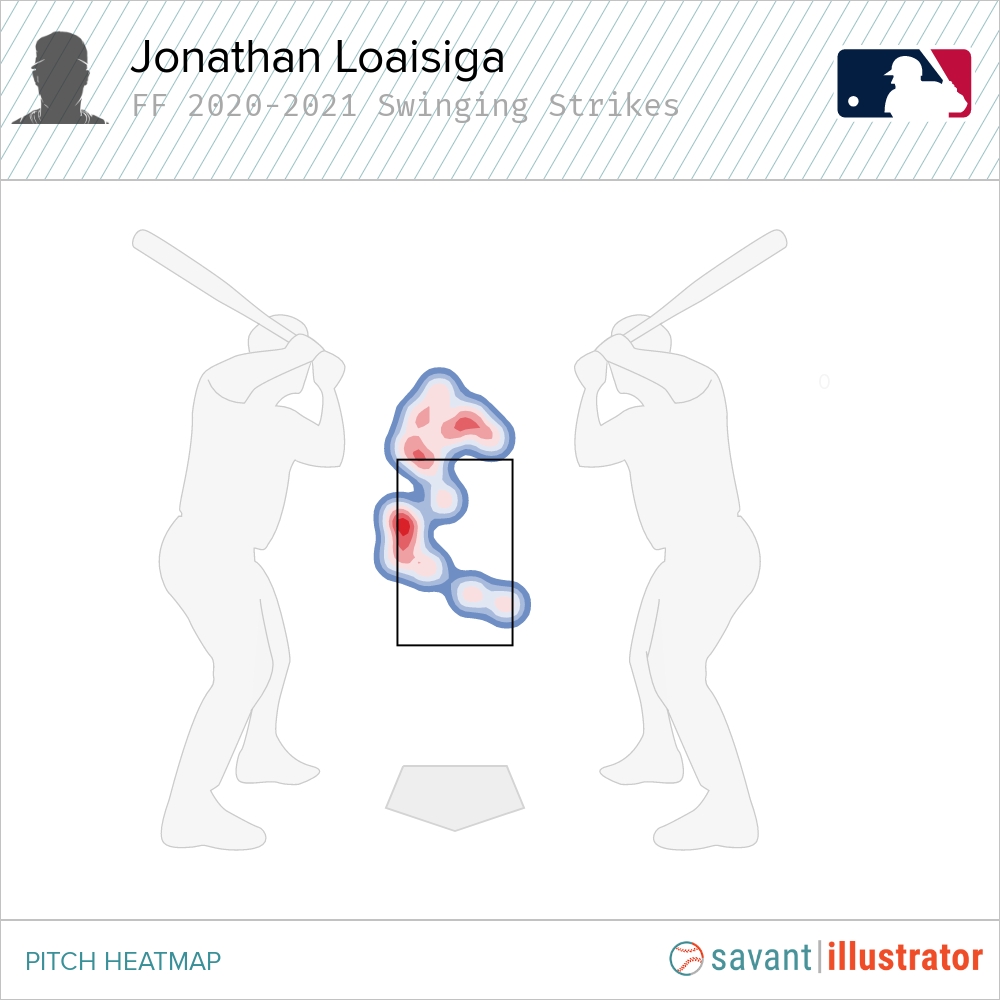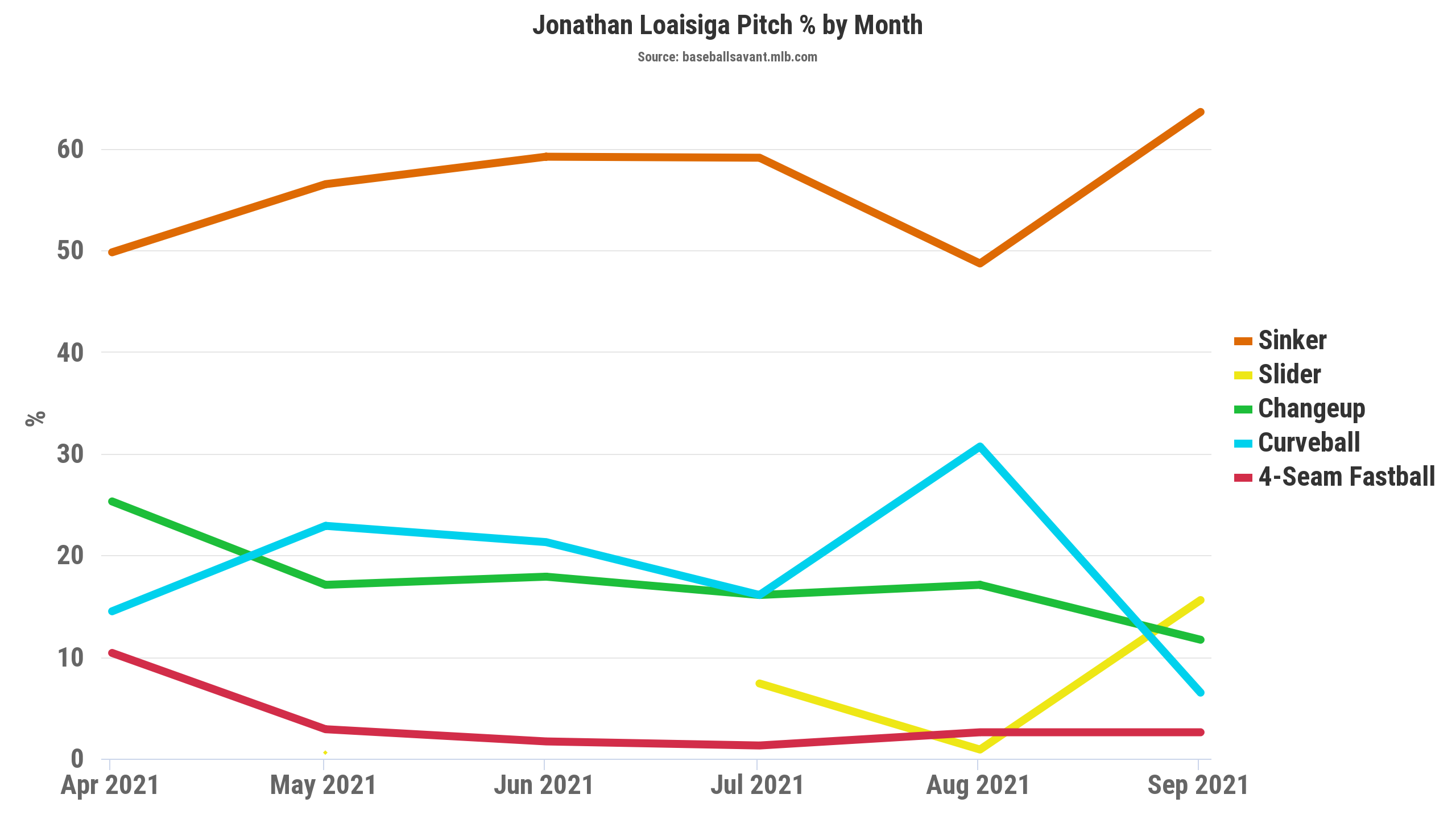After rotating between a reliever and a spot starter in his first three seasons in the Major Leagues (2018-2020), Jonathan Loáisiga made a full transition to the Yankees bullpen in 2021.
The move worked out for both the Yankees and the Nicaraguan-born pitcher, as Loáisiga not only pitched an MLB career-high 70.2 innings last season, but he also posted a 2.17 ERA and generated a 2.4 fWAR. According to Fangraphs, the 27-year-old led all Yankees relievers last season in fWAR. That list included Chad Green (1.6 fWAR), Lucas Luetge (1.4 fWAR), and Aroldis Chapman (0.6 fWAR), the latter who’s been the Yankees’ closer since 2017.
Additionally, a deep dive into Loáisiga’s strikeout and batted ball data should make Yankee fans and fantasy managers hopeful that his success last season can carry over into 2022 and beyond.
He increased his K rate from 22 percent in 2020 to 24.5 percent in 2021 as well as his K-BB rate from 15 percent in 2020 to 18.7 percent in 2021. Loáisiga also induced more weak contact, as his barrel rate allowed went from 6.0 percent in 2020 to 3.1 percent in 2021. He also generated more balls on the ground, as his ground ball rate went from 50.8 percent to 60.9 percent from 2020 to 2021, respectively.
With an xERA of 2.18 and FIP of 2.58, it’s safe to say that the advanced numbers confirm that Loáisiga may be their most promising arm out of the bullpen in 2022 and beyond. If manager Aaron Boone gives him a shot in the ninth, it isn’t out of the question to think that Loáisiga could be the next great Yankees closer, as he has the skill set to succeed in the role.
The main question of course for fantasy managers (and Yankees fans) is this though: Will he get that opportunity to be go-to guy in the ninth this season?
A critical key to that opportunity happening in this upcoming season is the continued development of his pitch usage and approach…
And how his sinker and slider will be utilized in 2022.
Replacing the Four-Seamer with the Sinker
From his rookie debut with the Yankees in 2018 up to the COVID-shortened 2020 season, Loáisiga primarily relied on his four-seam fastball. However, starting in 2019, Loáisiga introduced a sinker to his pitch arsenal.
After sparingly utilizing the pitch in 2019 and 2020, he committed to using the sinker as his primary pitch in 2021, which is demonstrated in the pitch usage chart from Baseball Savant below:

The four-seam fastball wasn’t necessarily a bad pitch for Loáisiga by any means, especially from 2018-2020.
Over those three seasons, Loáisiga still generated decent whiff and K rates on the four-seamer. However, when compared to his sinker, he was starting to see some regression in the ability to finish batters off with his four-seam fastball, which is demonstrated in the decline in his put away percentage over the past three years:
What makes Loáisiga sinker a more effective pitch than his fastball, though, is not necessarily the ability to generate more whiffs on the pitch. His four-seam fastball, even though it was utilized less last year and less effective on a run value end (more on that later), was better than the sinker when it came to generating swings and strikeouts.
However, what makes Loáisiga sinker so valuable is its ability to induce weak contact and a low launch angle on a consistent basis. It’s a big reason why his sinker was tied for fifth-best in baseball last season in terms of run value (-14), according to Baseball Savant.
The table below displays a comparison of Loáisiga four-seamer and sinker from 2019 to 2021. The data includes how much he utilized each pitch against left-handed and right-handed batters, in addition to average exit velocity, launch angle, spin rate, and pitch velocity numbers.
Velocity-wise, there hasn’t been much of a difference between the two pitches. Furthermore, his four-seamer has traditionally been the higher-spin offering, and over the past couple of seasons, he utilized the four-seam fastball more against left-handed batters, while the sinker has been thrown more against left-handed ones.
However, the big difference between the two pitches, especially since 2020, has been the tremendous disparity in average exit velocity and launch angle on batted balls.
In 2020 and 2021, the four-seamer was 9 MPH and 11.5 MPH higher than his sinker in terms of average exit velocity on batted balls. Furthermore, over the same time span, there was a difference of 20 and 30 degrees in terms of average launch angle between the sinker and four-seamer, respectively.
Considering that Loáisiga pitches home games in Yankees Stadium, which is the 12th-friendliest stadium when it comes to home runs, according to Baseball Savant park factors, it makes sense that Loáisiga fully embraced the sinker in 2021, especially considering how much better it is as a pitch when it comes to keeping balls in the yard.
Here’s an example of Loáisiga unable to keep the ball in the park against the Nationals back in May, as the light-hitting Josh Harrison smashes Loáisiga 97 MPH fastball over the left-field fence in the Bronx with an exit velocity of 105 MPH and launch angle of 25 degrees:
https://gfycat.com/immediatequickaphid
Now, let’s take a look at a sinker that Loáisiga threw back in May in Baltimore against the Orioles’ Maikel Franco.
The tailing movement and location of the 98.4 MPH sinker induce a ground ball that clocks in at 86.9 MPH in exit velocity and generates a launch angle of -31 degrees. The result is an easy double play for the Yankees in a one-run game in the bottom of the ninth:
https://gfycat.com/lightunderstatedattwatersprairiechicken
Does this mean that Loáisiga should completely abandon his four-seamer in 2022?
Not necessarily.
The four-seamer remains a high-velocity offering. When located properly, it can be an effective strikeout pitch, especially as a third or fourth option. When he has located the four-seamer in the upper edges of the strike zone, Loáisiga has been effective in generating swings and misses, which is evident below in this pitch heatmap of his four-seam fastball which encompasses the past two seasons.

Here’s an example of Loáisiga hitting that “hot spot” around zone 1 with a 97.7 MPH four-seamer that strikes out Travis Shaw of the Red Sox in the AL Wild Card game on October 5th:
https://gfycat.com/soulfuldesertedjaguarundi
Even with low usage, the four-seamer, with its high velocity, can be an effective weapon for Loáisiga in crucial put-away situations (i.e. two-strike counts).
That being said, Loáisiga’s resurgence last year had a lot to do with making his sinker his most utilized pitch in 2021.
Even though the sinker didn’t generate as high a K rate as his four-seamer, the pitch still generated some impressive swings and misses last season, especially with tailing movement that can make right-handed hitters, like Nelson Cruz, look silly:
https://gfycat.com/fluffyemptybandicoot
Hence, it is not a surprise that Loáisiga and his sinker regularly appeared on Pitcher List’s daily “Top 10 Nastiest Pitches” list last season.
It will be interesting to see if his sinker makes more or fewer appearances on this daily list in 2022.
Curveball or Slider in 2022?
Loáisiga ’s curveball has been his most-used secondary pitch over his four-year career. It makes sense considering how productive it has been on a run value, whiff, and strikeout end, as evidenced in the Statcast data in the table below:
However, an interesting trend began to develop over the last three months of the season, as Loáisiga introduced a slider to his arsenal starting last July. (He did technically introduce it in May, but he only threw it once that month and didn’t use it at all in the month of June).
After sparingly throwing it in July and August (7.4 percent and 0.9 percent usage, respectively), the slider was actually used more than the curveball in the month of September (15.6 percent usage), and became his most utilized secondary pitch during that time span as well, as shown in the monthly pitch usage chart below, via Savant:

Overall for the 2021 season, the curveball was a more effective breaking pitch for Loáisiga than the slider.
His curveball generated more swings and misses, and also was seven runs better than the slider on a run value end, as evidenced in the Statcast data in the table below.
Overall, Loáisiga threw the curve 18 percent more than the slider last season, and thus, it makes sense why his curveball had a much higher run value.
But what about in the month of September, when Loáisiga actually threw his slider more?
Here’s how that breakdown looked:
Interestingly enough, his lower spinning, but higher velocity slider generated a 7.1 percent higher whiff rate than his curveball in the month of September. This is a stark contrast to the overall season whiff rate, as his curveball generated a 14.3 percent higher whiff rater than his slider in 2021.
Loáisiga pretty much locates both pitches in the same part of the zone (low and away) and utilizes it primarily against right-handed batters. The main difference is that the curve tends to be a loopier offering, but he commands it well, so it doesn’t hurt him often.
Here’s Loáisiga getting Randy Arozarena swinging on an 84 MPH curveball that ties him up back in June:
https://gfycat.com/gentleunlinedjackal
Flash forward to October, and Loáisiga gets Arozarena swinging and missing again, only this time on a slider low and away in the zone that clocks in at 89.6 MPH.
https://gfycat.com/nervousflamboyantjanenschia
The slider does have less of a break on it than the curve. However, that could pair well with his sinker and four-seam fastball, which averaged in the upper 90’s in 2021.
Loáisiga has been too dependable with his curve to completely abandon it in 2022. However, the increased usage of his slider last September was a peculiar development in his pitch arsenal and its usage will be worth watching in the early months next season, especially for Yankees fans and fantasy managers who utilize Loáisiga in their bullpens.
Will Loáisiga Get a Shot at the Closer’s Role?
There is no question that Loáisiga’s profile is “ninth-inning” worthy both in the short and long-term for the Yankees, especially considering his age.
That being said, the Yankees bullpen is crowded, as Fangraphs’ Roster Resource projects Aroldis Chapman to continue his role as closer in 2022. Loáisiga on the other hand is predicted (at least initially) to share setup opportunities with Chad Green, who had a breakout year with a 3.12 ERA in 83.2 IP.
Nonetheless, Yankees fans are already rumbling that Loáisiga may get opportunities as the closer in the Bronx as soon as next season, especially since Green and Chapman will be free agents after next season:
Been thinking recently:
Aroldis Chapman + Chad Green are free agents after 2022. Who do you think starts the 2023 season as the Yankees closer?
Jonathan Loaisiga feels like the obvious answer right now. I like Clay Holmes in a more flexible role. Fun sleeper pick? Albert Abreu.
— Max Mannis (@MaxMannis) January 8, 2022
Yankees fans saying this is one thing. That being said, will manager Aaron Boone actually give him the opportunity in the ninth inning, especially in an upcoming season where Boone may be on the hot seat as manager after failing to do much in the postseason during his tenure?
If Boone digs deep into the data from 2021, the choice to utilize Loáisiga in the ninth should be a tempting one, even if may not be overwhelmingly obvious at first glance.
When looking at plate discipline data via Fangraphs in the table below, Loáisiga doesn’t appear to be much better than Green or Chapman, especially in the categories of CSW (called strikes plus whiff) rate and contact rate.
On the other hand, when it comes to batted ball and Statcast data, it’s a different story.
Loáisiga may not be as effective as Chapman and Green when racking up strikeouts. However, according to batted ball metrics, Loáisiga is much better in terms of not only generating more batted balls on the ground but also limiting hard contact and keeping the ball out of the ballpark, an effective skill when pitching home games in a hitter-friendly haven such as Yankees Stadium.
Here’s a look at the 2021 batted ball data from the three Yankees relievers:
Furthermore, here’s the 2021 Statcast data from the three as well:
As one can see, Loáisiga proved to be a far superior pitcher in comparison to Chapman and Green when it came to limiting those barrels and productive contact.
The Nicaraguan-born reliever is expected to continue refining his pitch repertoire a little bit more in 2022. (Is it going to be the sinker or four-seamer? Curve or slider?) If he finds the right pitch mix, it is possible that his K’s and CSW rate will only increase next season, which will make him an even more superior option in the ninth, especially since Green and Chapman don’t really compare in those Statcast and batted ball categories.
As for fantasy managers, Loáisiga should be a tempting option in upcoming drafts, especially when taking a look at his ADP.
Here’s a look at how the three Yankees relievers compare in terms of overall consensus ADP, as well as rankings in Real-Time Sports, NFBC, and Fantrax (with the data coming from Fantasy Pros):
Loáisiga comes in 266 spots behind Chapman on a consensus ADP end. In addition, he also lags behind Green in NFBC drafts as well (though he is generating a higher consensus, RTS, and FT ADP than Green).
If Chapman struggles, or if Loáisiga gets in Boone’s favor, Loáisiga could be a sleeper closer option in late rounds of drafts, in addition to being a long-term relief asset in keeper and Dynasty League formats.
Of course, that depends on whether or not Boone will look to the future sooner than expected with Loáisiga or just stay the course with the experienced, but volatile Chapman in the ninth in 2022 in an effort to protect his job as the manager in New York.
April and May could not only be an interesting two months for Boone and the Yankees but Loáisiga and his future in the Yankees bullpen as well.
Photos by Icon Sportswire | Adapted by Justin Redler (@reldernitsuj on Twitter)

